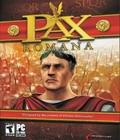Genre: Strategy
Publisher: DreamCatcher
Developer: Galilea
Release Date: November 7, 2003
Have you ever played a game that set out to be full on features but only ended up being too complex? Well, then perhaps you played Pax Romana for the PC. Confused? Allow me to explain a little. First off, Pax Romana is a game by Galilea studios where the goal is to prevent the Roman Empire from falling into pieces. It is a real-time strategy game with 2D graphics and a giant map of northern Africa and Europe. The map is split up into over one hundred regions. Pax Romana is all about tedious management, forcing you to juggle between the political, economic and military areas of an empire, which is no easy task. Sadly, Pax Romana does little to make the task easy on the player.
Set in the historical backdrop of ancient Rome, Pax Romana attempts to shove you into the role of managing an entire Empire. The job is narrowed down to two different games modes: strategic play and political play. Strategic play is the better of the two game modes, where the focus is establishing trade routes and eyeing up supply and demand, military movement and diplomacy. This game mode is all about carefully picking allies via bribes and sending your army to crush those who are not part of the alliance. The political game mode is where Pax Romana starts digging its own grave. I can tell that a lot of work went into placing the political system into the strategic area of the game, but the way it was implemented was less than desirable. Even after consulting the very well written manual numerous times during the hours of game play I still had trouble trying to execute certain things while playing. The manual may be filled with information, but does not explain enough on the subjects.
Many times I was left shoveling through menu after sub-menu trying to figure out how to best use my Roman Senate. Six factions make up the political playing field and they’re all pulling in the power struggle that is the Roman Senate. Each faction has its own leader and has their own senators as well as other necessary workers and, of course, gold. Each leader can also affect administration points, popularity ratings among other things. The Roman Senate is actually done very well and in a great amount of working detail and could make for a very interesting gaming experience. However, all of this is happening while the strategic element is trudging along behind it.
So you are faced with trying to contend with all that is happening with your senate as well as with your diplomatic friends. Both tasks might have been easier if the game had been giving a better interface to work with. The interface is far from workable though. You’ll have fun sifting through countless sub-menus and an amazing amount of buttons as you try and achieve even the simplest of tasks in Pax Romana. Factor all of that in as well as the timer when you are in the political forum. Yes, a timer and it’s still there in single player. The last thing that bothered me about the interface is that the pop-up windows are not easily moved, always in the way and hardly overlap they way you wish they would.
Graphics in Pax Romana are pretty plain as you might expect. Bright colors adorn the world map with each region being separated by regional boundaries. Little 3D-esque scenes are what you’ll see when talking to advisers much like most 2D RTS games. A lot of the text in the game also tends to be somewhat blurry and that can be pretty annoying with all the reading you have to do. The game’s sound effects work well enough since it isn’t exactly a complicated game sound wise, while the music is pretty standard but well done. It goes from gentle and quiet to the epic, booming music that all empires seemed to have.
There isn’t much else to say about Pax Romana. I feel as though a lot of effort and time went into making two very good game modes that clashed together into one jumbled mess. They might have worked out better if the designers had come up with a better gaming interface to work with, but they didn’t and because of that the game play is frustrating and boring. Who wants to work to play a game? I don’t often enjoy using scrap paper and making my own charts for a RTS game. These kinds of things should be already built-in. I can’t see anyone but extremely diehard Roman Empire gamers with a lot of time and patience on their hands enjoying this game.
Casual gamers beware.
Score : 3.0/10
More articles about Pax Romana




































